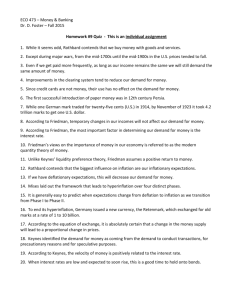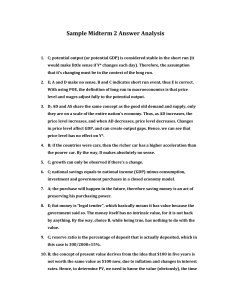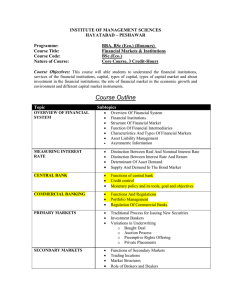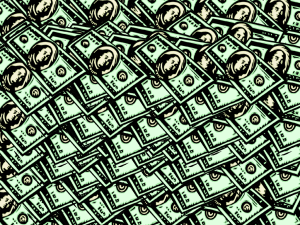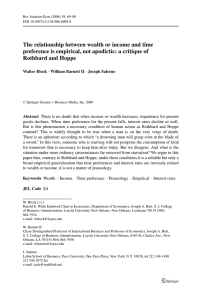The Demand for Money
advertisement
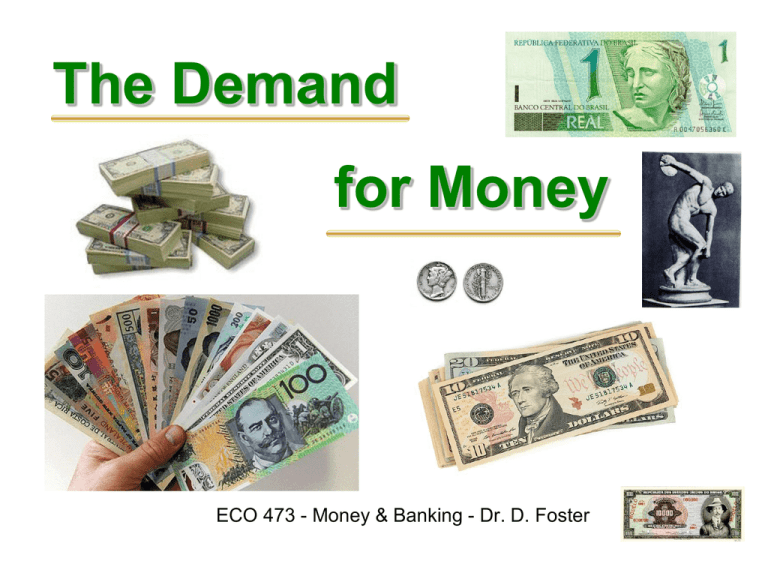
The Demand for Money ECO 473 - Money & Banking - Dr. D. Foster The Demand for Money • The motives for holding money • Money demand as a medium of exchange The Cambridge equation. The Inventory model. Friedman approach. Rothbard approach. • Money demand as a store of value Keynes’ portfolio demand. The Motives for Holding Money • Transactions motive: To use as a medium of exchange. Depends upon income, consumption, wealth. Not influenced very much by interest rates. • Portfolio motive: To hold money as part of a wealth building strategy. Depends on the interest rate. The Cambridge Equation Money is only used for making purchases. For some given income, Y, you plan to hold some given fraction, k, to facilitate purchases. As income rises (falls), the money demanded rises (falls). The Demand for Real Money Balances • Md is a “nominal” value - as prices rise, we want to hold more money, but not in real terms. So, to convert to “real” values . . . • Y = nominal income = (Prices) x (real income) = P•y • md eliminates price effects on money demand. Annual Spending Patterns with a Constant Rate of Spending for y = $36,000 $18,000 Average money holdings equals … ? $9,000 $1,500 The Inventory Approach to Money Demand • What is the optimal money balance to hold? • Assumptions: On-hand money earns no interest. People earn a fixed amount of real income. People buy goods and services at a constant rate. People hold either money or bonds. Bonds earn an interest return of r. Converting from bonds to money costs a fee, f. Conversion made n times/year in constant amounts. Summarizing factors affecting md real money balances • Real income: A rise in y causes an increase in md. A fall in y causes a decrease in md. • The interest rate: An increase in r causes a decrease in md. A decrease in r causes an increase in md. • The cash-conversion fee: An increase in f causes an increase in md. A decrease in f causes a decrease in md. Friedman approach Money demand varies with … • Permanent Income. + relationship. • Interest spread between bonds & money. - relationship. • Interest spread between stocks & money. - relationship. • Inflationary expectations. - relationship. Rothbard approach Money demand varies with … • Frequency of payments. - relationship. • Sophistication of the clearing system. - relationship. • Confidence in money (esp. paper). + relationship. • Inflationary expectations. - relationship. Mises: Phase I Phase II Phase III Rothbard presentation Money S&D in the context of the ppm: ppm ms ms' In Phase I, MS rises but its effects are offset by Md. In Phase II, Md falls, incorporating inflationary expectations. md' d m md'' $ Phase III, further increases in MS are constantly offset by declines in Md as people seek to have zero cash. Keynes & the Portfolio Demand • The speculative demand for money: Relates to money held as a store of value. We seek to maximize our wealth over time. Our wealth is held in the form of bonds. Holding money allows us to time bond purchases. At “high” interest rates, we expect them to fall … raising bond prices; strategy - buy bonds now. At “low” interest rates, we expect them to rise … lowering bond prices; strategy - sell bonds now. Keynesian Money Demand r r md(T) md(S) m Money demanded for transactions purposes in the Cambridge equation isn’t related to the interest rate. [Also, Friedman & Rothbard.] m Keynes’ speculative demand shows money is related to the interest rate. The Liquidity Trap Increasing the MS doesn’t actually lower interest rates! Or, increasing the MB doesn’t actually increase the MS! Is the U.S. in a Liquidity Trap? Fight Recession by interest rates The Fed has run out of an interest rate policy! Effective Federal Funds Rate of Interest 1981 to 2011 20.00% 1982 18.00% 16.00% 14.00% 1991 12.00% 2001 10.00% 2009 8.00% 6.00% 4.00% Jan-11 Jan-09 Jan-07 Jan-05 Jan-03 Jan-01 Jan-99 Jan-97 Jan-95 Jan-93 Jan-91 Jan-89 Jan-87 Jan-85 Jan-83 0.00% Jan-81 2.00% What has the Fed done? The Monetary Base has more than quintupled! 2004-2008: ~ $800 b. 9/2015: $4,028 b. The Demand for Money ECO 473 - Money & Banking - Dr. D. Foster
